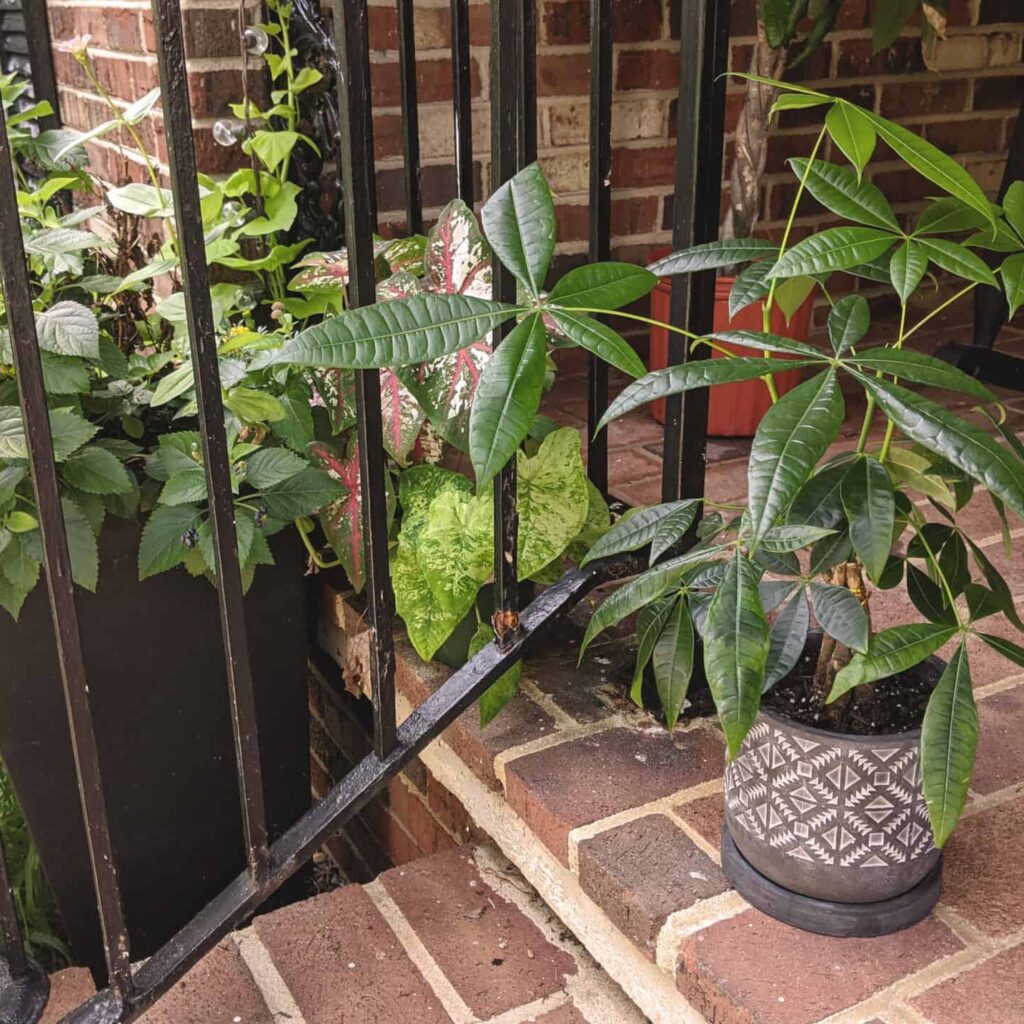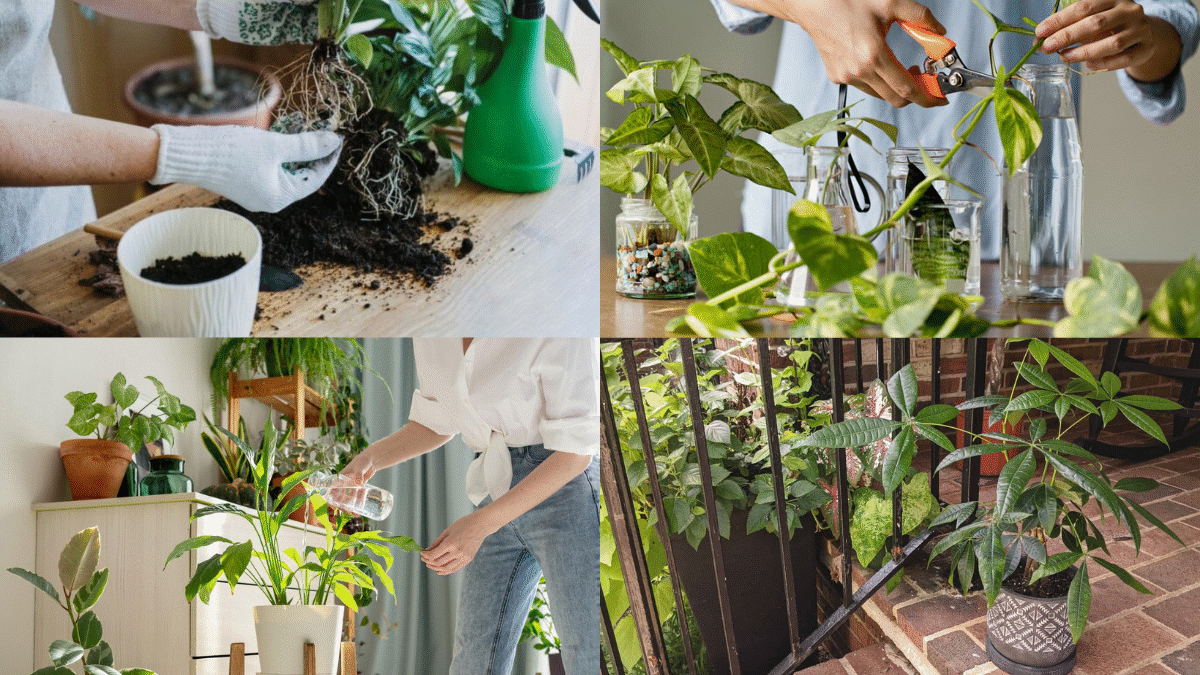The money plant — also known as Pothos, Devil’s Ivy, or Epipremnum aureum — is one of the most popular and beloved houseplants around the world. Valued not only for its attractive heart-shaped leaves and trailing vines but also for the positive energy and prosperity it’s believed to bring according to Feng Shui and Vastu Shastra, the money plant is a low-maintenance, hardy plant perfect for both beginners and seasoned plant parents.
In this detailed guide, we’ll cover everything you need to know about how to care for a money plant, from choosing the right variety to watering, sunlight, soil preferences, propagation, and dealing with common problems. Follow these care tips, and your money plant will thrive — adding lush greenery and good vibes to your space.

About the Money Plant
The money plant is native to Southeast Asia and thrives in tropical and subtropical climates. Its trailing vines can grow up to 10–15 feet long indoors if given the right care. It’s a fast-growing, adaptable plant that can be grown in water, soil, or even as a climbing vine around a support.
While it’s commonly called a “money plant,” its name varies across cultures:
- Golden Pothos (due to its variegated golden-green leaves)
- Devil’s Ivy (because it’s nearly impossible to kill)
- Silver Vine (for certain cultivars)
Its versatility, resilience, and aesthetic appeal make it a staple in homes, offices, and gardens.
Different Types of Money Plants
There are several popular varieties you might encounter:
- Golden Pothos: Green leaves with golden-yellow streaks.
- Marble Queen Pothos: Creamy-white variegated leaves.
- Jade Pothos: Solid, deep green foliage.
- Neon Pothos: Bright, lime-green leaves.
- Manjula Pothos: Wavy leaves with green, silver, and cream variegation.
Ideal Light Conditions
Money plants are remarkably adaptable, but they do best in bright, indirect light.
Light Tips:
- Place your plant near a window with filtered light.
- Avoid direct sunlight, which can scorch the leaves.
- In low-light areas, growth may slow, and variegation can fade.
- Artificial fluorescent light also works well, making it ideal for offices.
How to Water a Money Plant
One of the most important aspects of money plant care is proper watering. These plants prefer a “moist but not soggy” approach.
Watering Guidelines:
- Water thoroughly when the top 1–2 inches of soil feel dry to the touch.
- Avoid overwatering, which can lead to root rot.
- Reduce watering frequency during cooler months.
- If growing in water, change the water every 7–10 days and clean the container to prevent algae buildup.
Tip: Always ensure your pot has drainage holes to prevent water from accumulating at the bottom.

Best Soil for Money Plants
Money plants aren’t fussy about soil but perform best in a well-draining, fertile potting mix.
Ideal soil mix:
- 1 part garden soil
- 1 part sand or perlite (for drainage)
- 1 part compost or organic matter
This combination ensures good aeration and nutrient retention.
Temperature and Humidity
Being a tropical plant, the money plant thrives in warm, humid conditions.
Temperature:
- Ideal: 65°F to 85°F (18°C to 29°C)
- Avoid temperatures below 50°F (10°C)
Humidity:
- Prefers moderate to high humidity.
- Mist the leaves occasionally, especially during dry winter months or in air-conditioned rooms.
Feeding and Fertilizing
Money plants are not heavy feeders but appreciate occasional nutrients to keep them healthy and lush.
Fertilizer Tips:
- Use a balanced, water-soluble houseplant fertilizer (e.g., 10-10-10) once a month during the growing season (spring and summer).
- Cut back feeding in fall and winter.
- Avoid over-fertilizing, as it can cause leaf browning.
Pruning and Maintenance
Pruning helps control the size, encourage bushier growth, and remove dead or yellowing leaves.
How to Prune:
- Use clean, sharp scissors to snip off leggy or damaged stems.
- Cut just above a leaf node to encourage new growth.
- Regularly wipe the leaves with a damp cloth to remove dust and enhance photosynthesis.
Tip: Money plants can be trained to climb on trellises, walls, or hanging baskets for a beautiful cascading effect.
Propagation: Grow More from Cuttings
One of the easiest plants to propagate, money plants can be multiplied from stem cuttings.
Propagation Steps:
- Choose a healthy stem with at least 4–5 leaves.
- Cut the stem just below a node.
- Remove the bottom 1–2 leaves.
- Place the cutting in a glass of water or directly in soil.
- Keep in indirect light.
- Change water every week if propagating in water.
- Roots typically appear within 2–3 weeks.
Once roots are about 2 inches long, transplant the cutting into soil for continued growth.

Growing Money Plant in Water
Many plant lovers prefer growing money plants hydroponically in bottles, jars, or vases.
How to Grow in Water:
- Use clean, room-temperature water.
- Place cuttings in a glass container filled with water, ensuring nodes are submerged.
- Change the water weekly.
- Add a drop of liquid houseplant fertilizer monthly for nutrients.
Tip: Avoid placing water-grown money plants in direct sunlight to prevent algae growth.
Common Money Plant Problems and Solutions
Though generally easy to care for, money plants can face occasional issues:
- Yellow Leaves: Overwatering or poor drainage.
- Brown Leaf Tips: Low humidity or excessive fertilizer.
- Slow Growth: Insufficient light or nutrients.
- Pests (Mealybugs, Spider Mites): Wipe leaves with a soapy water solution or neem oil.
Prevention: Regular inspections, proper watering, and good air circulation will help avoid most problems.

Benefits of Keeping a Money Plant
Beyond aesthetics, the money plant is believed to bring luck, prosperity, and positive energy into homes and offices. Its benefits include:
- Air Purification: Removes indoor pollutants like formaldehyde and benzene.
- Stress Reduction: Greenery soothes eyes and boosts mood.
- Low Maintenance: Perfect for beginners and busy individuals.
- Versatility: Can be grown in water, soil, or hanging baskets.
Final Thoughts
The money plant is a delightful, easy-care houseplant that enhances your indoor space with its lush green foliage and positive vibes. By providing the right balance of light, water, and nutrients, along with regular pruning and occasional propagation, you can enjoy a thriving, beautiful plant all year long.
Whether you believe in its prosperity-bringing reputation or simply love its trailing vines, the money plant is a wonderful addition to any plant collection.





Leave A Comment